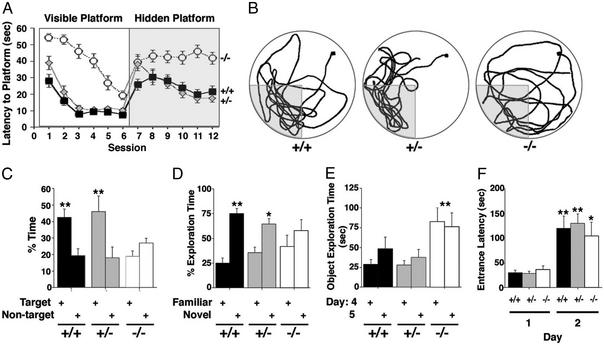Figure 4.
WAVE-1 null mice are impaired in spatial and nonspatial but not in emotional learning and memory. (A) Morris water maze. Time to swim to the platform (latency) was measured for wild-type (black squares), heterozygous (gray diamonds), and WAVE-1 null (white circles) mice. The mice were tested in two daily sessions of three trials each. Sessions 1–6 (Left) represent learning trials for the visible platform, and sessions 7–12 (Right) represent learning trials for the submerged hidden platform. Session averages ± SEM are represented. Although all groups learned to locate the visible platform location (P < 0.01), WAVE-1 knockout mice required significantly more time to reach the platform (P < 0.01 −/− vs. +/+ and +/−, Tukey–Kramer). In contrast, wild-type (P < 0.05) and heterozygous (P < 0.01) mice learned to locate the hidden platform, but the WAVE-1 knockout did not (P = 0.833). (B) Representative swim-path traces for wild-type (+/+), heterozygous (+/−), and knockout (−/−) mice during the probe trial (platform removed). The start position is marked by a black square, and the target area is indicated by the shaded area. (C) The percentage of time spent in target vs. nontarget areas during the probe trial for wild-type (+/+), heterozygous (+/−), and knockout (−/−) mice is indicated. The wild-type and heterozygous mice spent significantly more time in the target area than any of the nontarget areas (P < 0.01, Tukey–Kramer) than the knockout (−/−) mice. (D and E) Novel-object recognition. (D) The percentage of object-exploration time spent with the familiar and novel objects is presented. Wild-type (+/+, P < 0.01) and heterozygous (+/−, P < 0.05) mice spent a significantly greater percentage of time exploring the novel object, indicating intact object recognition. WAVE-1 knockout mice (−/−) did not spend a greater percentage of time exploring the novel object (P = 0.375). (E) The total times spent exploring both objects. Wave-1 knockout (−/−) mice spent significantly more time exploring both objects on days 4 and 5 than wild-type (+/+) and heterozygous (+/−) mice (**, P < 0.01 −/− vs. +/− and +/+, Tukey–Kramer). (F) Passive-avoidance test. The latency to enter the dark chamber on days 1 and 2 is shown. All groups took significantly longer to enter the dark chamber on day 2 than day 1, and there were no genotype differences (*, P < 0.05, and **, P < 0.01, day 2 vs. day 1).

